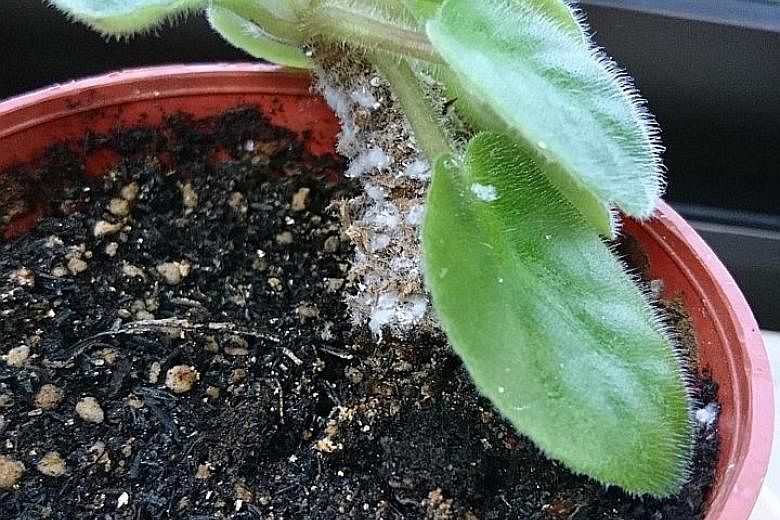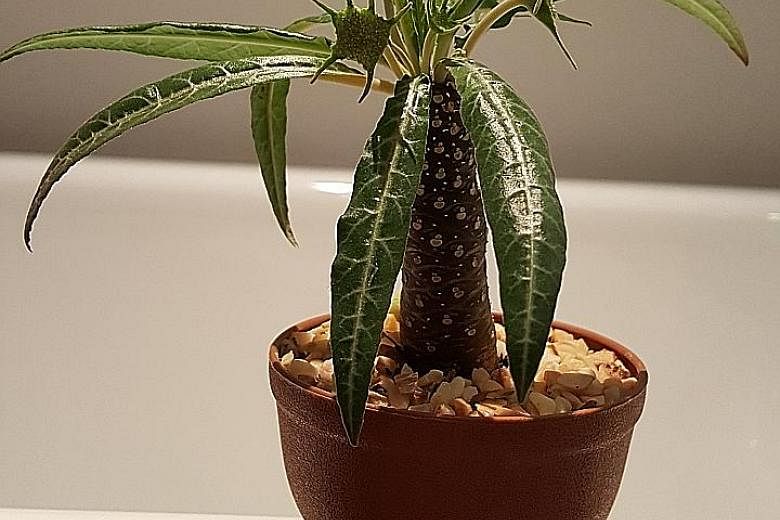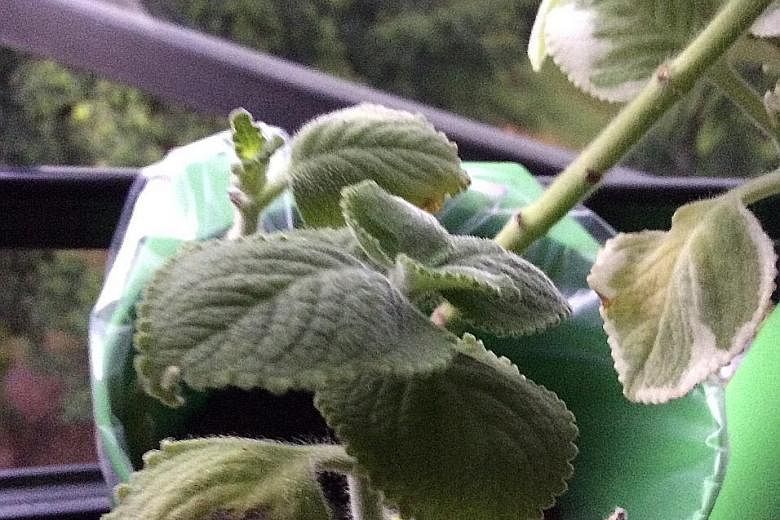Counter mealy bugs with pesticides
I have been growing some plants in the office for a couple of years and noticed white spots on their leaves and stems recently. The plants are also weak and no new leaves have grown. The white spots are sticky and have spread to all the plants, though they affect the plants differently. What should I do to remove the spots?
Sharon Law
The white spots are likely to be mealy bugs, a common pest found on the African violet (its botanical name is Saintpaulia ionantha).
Mealy bugs are found on plant parts above the soil, while soil mealy bugs attack the roots. These pests suck sap from the plant and gradually weaken it.
Mealy bugs on plant parts above the soil can be managed by spraying a pesticide such as pyrethrum, which is derived from a type of chrysanthemum.
Ready-to-use formulas can be bought from gardening sections at supermarkets here. Soap solutions, neem oil and summer oil can also be used, but these need to be diluted first. A concentrated dosage can burn furry plants.
For mealy bugs found among the roots, a chemical pesticide such as malathion may be applied as a soil drench. A solution of the pesticide is made and poured onto the root zone.
Note that for any pesticide, repeated applications may be required to keep pest populations under control.
Kapok tree produces fluff that can stuff pillows
Is this tree with thorns on its bark poisonous?
Joseph Koh
This tree is commonly known as the Kapok or silk cotton tree. Its botanical name is Ceiba pentandra.
It has many hanging fruit which burst open and release fluffy, yellow fibre. This material was once harvested to fill pillows.
The sharp thorns protect the tree as they make it difficult for animals or insects to climb. However, the thorns gradually drop as the tree matures.
Avoid touching the thorns. If you get cut by one of them, clean the wound thoroughly and get it checked by a doctor to avoid any infection.
Grow succulent in gritty mix under filtered sunlight
Is this plant a miniature palm and how do I care for it in Singapore's tropical weather?
Fong Weng Khin
The plant is botanically known as Dorstenia crispa var. lancifolia. It is a drought-tolerant succulent that has a fat stem.
Grow it in a well-draining, gritty mix, instead of a moisture-retentive soil mix, to prevent the plant from rotting. Allow the soil to dry slightly between watering cycles, but not completely.
The succulent grows best when it is under filtered sunlight for at least four hours a day.
Its seeds have star-shaped heads that are expelled explosively when ripe. These can travel up to several metres and tend to land in nearby flowerpots.
Wild Cape Gooseberry fruit can be eaten when ripe
What is this plant and can its fruit be eaten?
Heng Hua Pheng
The plant is commonly known as the Wild Cape Gooseberry and its botanical name is Physalis minima.
Itgrows as a weed in gardens and wastelands. Its seeds are often disseminated by birds.
A member of the tomato family (Solanaceae), its fruit are edible when fully ripe.
You can tell that the fruit are ripe by their dried outer layer that covers a bright orange berry.
Indian Borage needs more sunlight, well-draining soil
My mint plants have not been growing well since I moved house. They used to be placed in the void deck, but when I moved, I put the pots on the balcony floor. The leaves turned yellow and looked burnt. So I changed the soil, repotted the plants and put them at the window away from direct sunlight. However, the plants did not get better. Why does this happen and what can I do to save them?
Genny Cheng
The plant pictured is not a true mint. It is known as Indian Borage or by its botanical name, Plectranthus amboinicus.
Your plants may not have enough sunlight, which could be the cause of their poor growth and health. They need to be under direct sunlight for four to six hours daily.
The soil needs to be well-draining and allowed to dry out a little before the plants are watered again.
A lack of sunlight and constantly moist soil will cause the plant to have a range of diseases such as leaf spots and stem rot.
•Answers by Dr Wilson Wong, a certified practising horticulturist and founder of Green Culture Singapore (www.greenculturesg.com). He is also an NParks-certified park manager.
•Have a gardening query? E-mail it with clear, high-resolution pictures of at least 1MB, if any, and your full name to stlife@sph.com.sg





